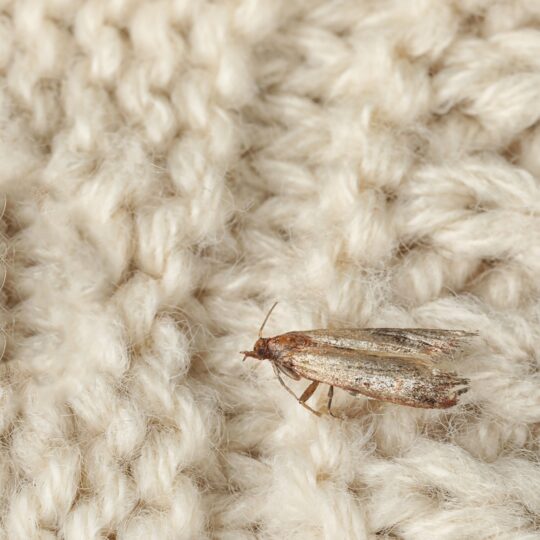How Difficult Are Clothes Moths to Eliminate?

Not all pests bite, sting, or do obvious damage to your property. Some pests live in silence, with the only evidence of their existence occurring when you see an adult version flying around your home.
That is the case with clothes moths. These tiny little moths are “cute” by most standards, as they’re small, flutter softly, and do not have any “scary” looking appearance. They’re also harmless to humans and, while they do leave a mark behind when you squish them, they typically do not cause much distress on their own unless you have a phobia.
But while these moths may not be a more traditional problem like cockroaches or spiders, they represent a very different problem and – unfortunately – they can also be harder to catch and treat.
What Makes Clothes Moths So Damaging?
Clothes moths, sometimes referred to casually as “cloth moths,” eat cloth. They especially love the cloth used to make clothes. That is because this type of cloth hides in safe, dark closets, allowing the moths to feed in relative safety.
What makes this even more challenging is that it’s not the adult moths that fly around the room that eat the cloth. It is the larva – larva that are all very small and almost impossible to see. It is rare that you see the larvae, instead you see the adult moths and, if you inspect your clothing, you see the holes they have left behind.
Why Cloth Moths Are Difficult to Remove
Cloth moth infestations can linger for extended periods of time, largely because their life cycle is hidden and their food sources are often undisturbed. These pests are not drawn to crumbs or kitchen waste, which you can easily clean. They feed on natural fibers, especially ones that are stored away, rarely moved, or kept in dark places.
Larvae often live deep in closets, beneath furniture, inside storage boxes, or between carpet and baseboards. Most people do not notice a problem until they find holes in clothing or textiles, which may be months after the infestation began. Female moths can lay up to 100 eggs, and those eggs can hatch quickly under the right conditions.
Moths target protein-based fibers like wool, silk, feathers, and even pet hair, which are often found in areas homeowners don’t routinely clean. Vacuuming can help in theory, but larvae and eggs that are lodged deep in fabric or cracks may survive light cleaning, and very few people have the time or tools to vacuum all of their well hidden clothes.
Even when adult moths are captured or removed, any surviving eggs or larvae will continue the cycle unless the entire habitat is treated.
Effective Strategies for Elimination
While challenging, cloth moth infestations can be addressed with a combination of targeted intervention and ongoing prevention.
Treatment typically involves identifying all affected areas and treating them simultaneously. That may mean professional cleaning of rugs and upholstered furniture, careful laundering or freezing of fabrics, and, in many cases. application of residual insecticides by a pest control company with experience in fabric pests.
For long-term success, prevention is equally important. That includes:
- Sealing and storing vulnerable items in airtight containers.
- Regular vacuuming and inspecting carpets and furniture.
- Using pheromone traps to monitor moth activity.
- Ensuring closets and storage areas are clean and well-ventilated.
Because of how quietly these moths operate and how persistent their life cycle can be, clothes moths are not a pest that disappears without effort.
If you suspect that you have a problem with clothes moths, the best thing you can do is reach out to ExtermPRO. We can provide you with helpful information about these pests, use traps, and even differentiate between clothes moths and similar pests, like Indianmeal moths, which look incredibly similar but are actually a type of pantry pest.
Let ExtermPRO help you with your pest problems. Contact us today to get started.